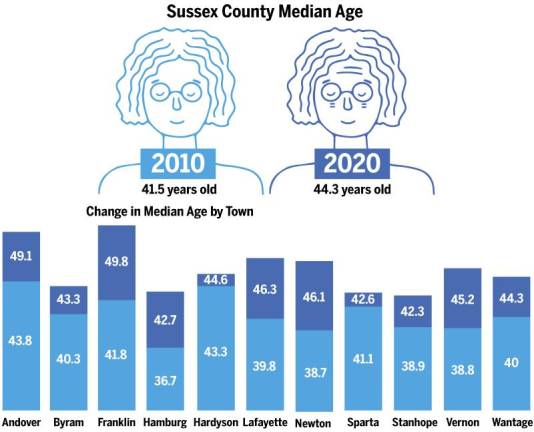2020 Census shows Sussex County residents aging and leaving
How did the makeup of Sussex County change in the last decade? Straus News looked at the census numbers for a slice of Sussex County and found a shrinking, aging, and more diverse population.

Sussex County sees steepest population drop in NJ
Sussex County’s population decreased by 3% between 2010 and 2020. Compared to other counties in the state, Sussex County’s 3% population drop is the steepest, followed by Cape May, Cumberland, and Salem Counties, which all saw a 2% decrease.
“Areas where populations are declining makes it more difficult for existing businesses and services to survive,” said Alan J. Sorensen, a Planning Commissioner for Orange County, N.Y.
The state of New Jersey, however, saw a 6% increase in population during this time. Hudson, Essex, and Ocean Counties saw the largest influx of people over the decade.
Of the towns examined (Vernon, Sparta, Byram, Hardyston, Wantage, Hamburg, Franklin, Lafayette, Andover, Stanhope, and Newton) Newton is the only area that saw an increase in its population. Vernon and Lafayette saw the sharpest decline, down 7% over the decade.
Editor’s Note: 2020 census data was collected between April and October 2020 at the onset of the COVID-19 pandemic. The census also published an updated, estimated population data for July 2021 – in all towns studied, the numbers are only slightly higher than the official 2020 census data.
Hispanic and Latino population grows
While the overall population in Sussex County dropped, the number Hispanic and Latino individuals increased 49% between 2010 and 2020. The largest Hispanic or Latino communities are in Vernon (2,163) and Sparta (1,570).
The towns that saw the largest percent change in Hispanic or Latino population over the decade were Franklin, N.J. where the population increased 67%, from 395 to 661, and Byram, where the population increased 64%, from 417 to 683.
Growing older
The population in Sussex County is growing older across the board. Of the towns studied, Newton and Franklin saw the most rapid aging process, with the median age increasing 19% in both communities.
“With that, there will be an increase in demand for services to support the senior community, whether that’s senior housing, public transportation, maybe Dial-A-Bus, or even paratransit to help seniors get around senior communities,” added Sorensen. “And of course, an increased demand for health services for the senior population.”
Money moves
The median household income in the county increased by 14% from 2010 to 2020.
Of the towns studied, Sparta is the most affluent, reporting a median household income of $137,372. Newton’s median household income was the lowest – but saw the largest percentage hike over the decade, jumping 37% from $48,702 in 2010, to $66,763 in 2020.
Lafayette and Byram saw the slowest growth, with incomes increasing 6% and 8%, respectively.
Love in Sussex County
Looking for love? In the populations Straus News studied...
The highest percentage of single adults live in Newton; 35.7% of adults never married. Franklin has the largest number of divorcees, with 20.8% of adults either divorced or separated. And Lafayette looks to be in wedded bliss; 67.8% of adults are married.


